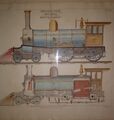Dominion Atlantic Railway Digital Preservation Initiative - Wiki
Use of this site is subject to our Terms & Conditions.
W&AREVANGELINE
Windsor and Annapolis Railway Steam Locomotive No. 1 "Evangeline" (I)
- Wheel Arrangement: 4-4-0
- Built by: Messrs. Fox, Walker & Co.
- Date: 1868
- Builder No.:
- Cylinders: 16" x 22"
- Drivers: 61"
- Wheelbase length, (engine and tender): xx' yy"
- Length of Wheel base 20' 8" inches
- Do. to centre of Bogie 17' 9"
- Do. of Bogie 5' 0"
- Overall pilot to tender coupler length: xx' yy"
- Capacity of tender: 2,000 gallons
- Name Origin: Evangeline was the heroine and lover of Gabriel in Longfellow's epic 1847 poem Evangeline, A Tale of Acadie'.
"Evangeline" and No. 2 "Gabriel" were a pair of locomotives landed at Wolfville in November 1868[1] or early 1869[2] built by the Fox, Walker and Company of Bristol, England. They were the first new locomotives ordered by the Windsor and Annapolis Railway as the company moved to bolster a fleet of second hand locomotives used in construction with these powerful locomotives to provide service on the new line. The pair were followed by four more Fox Walker locomotives landed later in 1869 (Gaspereaux, Minnehaha, Hiawatha, and Grand Pre). These locomotives established a naming connection of using Longfellow and Acadian history names for locomotives that would live on with the DAR.
The Fox Walkers used an interesting mix of British and American design features which produced a successful design, long remembered for their power. The featured a higher than normal boiler pressure of 200 psi which was very useful in winter.[3]
Evangeline" and "Gabriel" were described in a engineering book from the period:
"Mixed traffic engine constructed by Messrs. Fox, Walker & Co., Bristol, for the Windsor and Annapolis Railway, Nova Scotia. This engine is in general design in accordance with the prevailing American type of passenger engines having four coupled wheels and a bogie The resemblance ends there for the engine is entirely English in detail which appears to be much appreciated by the officials of lines on which the engine is at work The bogie is strongly constructed with plate framing and inside bearings and besides having the ordinary rotating movement on a pivot it may traverse laterally for a few inches A slight lateral movement has also been provided for in the axle boxes of the driving wheels There are 150 flue tubes 2 inches in diameter and as the barrel of the boiler is 4 feet 2 inches in diameter there is abundant space for the generation of steam and circulation of water The tender holds 2,000 gallons of water and is carried on two four wheel bogies."[4]
Three men came with the Fox Walker locomotives from England in 1868: Thomas Legge, who became locomotive foreman at the W&AR shops in Kentville and two machinists George Jepson and John Waugh.[5]
The broad gauge "Evangeline" was traded to the Canadian Government's Intercolonial Railway in 1875 when the Windsor & Annapolis changed to standard gauge. The W&AR received another locomotive in return, W&AR No. 1, which they also named Evangeline and which eventually became a DAR locomotive No,. 14.[6] The use of these names twice has caused some confusion with photos of the first Evangeline Gabriel sometimes being labelled as their successor locomotives. Evangeline was converted to standard gauge by the Intercolonial and sent to Manitoba to work on construction of the Canadian Pacific Railway and was eventually renumbered as CPR 152.[7]
A large working model of the Fox Walker "Evangeline" was built to carry visitors around the theme park at Upper Clements in 1989. After the park went out of business in 2019, the Evangeline model was sold to a you-pick blueberry farm in Aulac, New Brunswick.[8]
Gallery
Colour drawing and cross section by the Fox Walker Company of the Windsor & Annapolis locomotive No. 1 "Evangeline", 1868.
Detail of title and steam dome from colour drawing by the Fox Walker Company of the Windsor & Annapolis Railway locomotive No. 1 "Evangeline", 1868.
Detail of the wheel splasher with engine name from colour drawing by the Fox Walker Company of the Windsor & Annapolis Railway locomotive No. 1 "Evangeline", 1868.
Detail of cab side with builders plate from colour drawing by the Fox Walker Company of the Windsor & Annapolis Railway locomotive No. 1 "Evangeline", 1868.
Windsor & Annapolis train at Kentville Station with the locomotive No. 1 "Evangeline" leading and the St. Croix (?) behind. circa 1872.
Model of the Windsor & Annapolis Engine "Evangeline" at the Upper Clements amusement park, photographed by Dennis G. Jarvis, July 14, 2016.
References and Footnotes
- ↑ Marguerite Woodworth, History of the Dominion Atlantic Railway, page 62
- ↑ W.W. Clarke, Clarke's History of the Earliest Railways in Nova Scotia, (circa 1925), page 5
- ↑ Robert R. Brown, "British and Foreign Locomotives in Canada and Newfoundland", The Railway and Locomotive Historical Society Bulletin, No. 43 (April, 1937), p. 12
- ↑ Zerah Colburn, Daniel Kinnear Clark, Locomotive Engineering, and the Mechanism of Railways: A Treatise on the Principles and Contruction, Volume 1, London and Glasgow: William Collins, Sons, and Company (1871) Page 274
- ↑ W.W. Clarke, page 5
- ↑ J. B. King, "WAR Motive Powers Presents Thorny Problems", Chronicle Herald, May 24, 1958
- ↑ Robert R. Brown, "British and Foreign Locomotives in Canada and Newfoundland", The Railway and Locomotive Historical Society Bulletin, No. 43 (April, 1937), p. 12
- ↑ Alana Pickrell, "Former Theme Park Train Finds New Home at NB Blueberry Farm, CTV News, July 31, 2023





